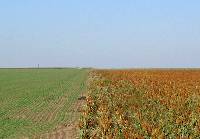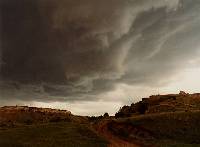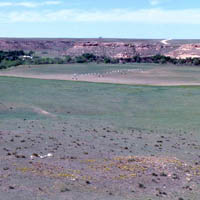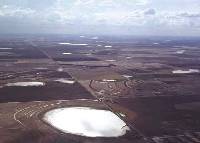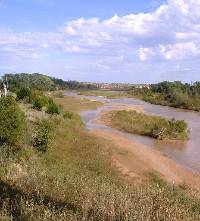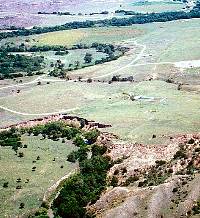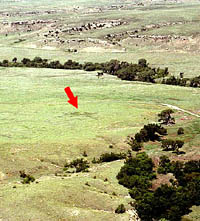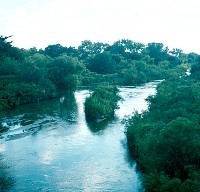
Wolf Creek in the northeast corner
of the Texas Panhandle is a permanent stream fed by
the Ogallala formation. It flows east into Oklahoma
and then swings northeast to join the North Canadian
River, one of the major tributaries of the Arkansas
River system. For the Buried City people, the Wolf Creek
Valley was a well-watered and thickly wooded oasis amid
the dry grassy sea of the High Plains. Photo by David
Hughes.
Click images to enlarge
|
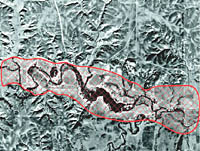
Aerial photograph taken in 1937 of
the Wolf Creek Valley highlighting the dense Buried
City settlement zone. Stone-based structures are distributed
along the terraces of this valley every 80 to 150 meters
(87 to 163 yards) and are clustered in small villages
or hamlets. Graphic by David Hughes.
|
|
The "Buried City" of the Texas
Panhandle is not, in fact, the remains of a city, but
it is one of the most densely settled archeological districts
in the Southern Plains. Packed into a few short miles
of narrow Wolf Creek valley are more than 100 known habitation
sites with the remains of houses mainly built by Plains Villagers
between about A.D. 1200 to A.D. 1400. It is very likely that
many other less-obvious (and perhaps earlier) pithouses lie
buried within the Wolf Creek Valley. Buried City or not, the
name has stuck and can refer both to the settlement zone along
Wolf Creek and to the Plains Village culture that called this
place home 700 years ago.
Since the 1920s Buried City has been equated
with one or another surrounding prehistoric cultures including
the Pueblo "Cliff Dwellers" of the American Southwest,
the Antelope Creek villagers of the Canadian River, and the
Woodland "Mound Builders" of the Kansas City area
and points further east. Today the facts, as we see them, don't fit any of these notions. Instead, investigations
over the past two decades have shown that Buried City was
part of a distinct culture of its own, one of a growing number
of variations on the Plains
Village theme that archeologists now recognize.
The people of the Buried City practiced horticulture,
a form of low-intensity gardening that led to full-scale agriculture
in other areas. They grew corn and probably squash, beans,
and other crops. But they were also buffalo hunters and hunters
of deer and other game. And they harvested wild fruits, seeds,
flowers, and other plant foods. For more than three centuries,
people lived, worked, planted, and harvested crops, hunted,
and died along this small stretch of Wolf Creek in what is today
the Texas Panhandle.
This exhibit summarizes what we now know about
the Buried City and the villagers who lived there. Below is
an introduction to the natural setting of the Wolf Creek Valley.
In other exhibit sections you can learn about the History
of Investigations, Buried City Settlement, Buried
City Architecture, Traces of Life, Buried City
Reconsidered, and Credits and Sources.
|
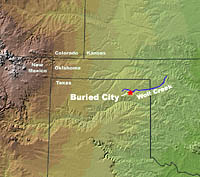
Location of Buried City and Wolf
Creek. Base map from NationalAtlas.gov.
|
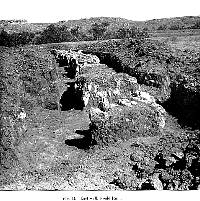
Photograph of Warren K. Moorehead's
1920 excavation of "Gould Ruin" also known
as "Eyerly's Temple," the largest structure
at Buried City and the only known multi-room building.
From Moorehead, 1931.
|
|





